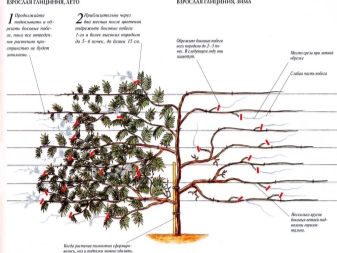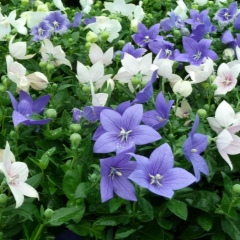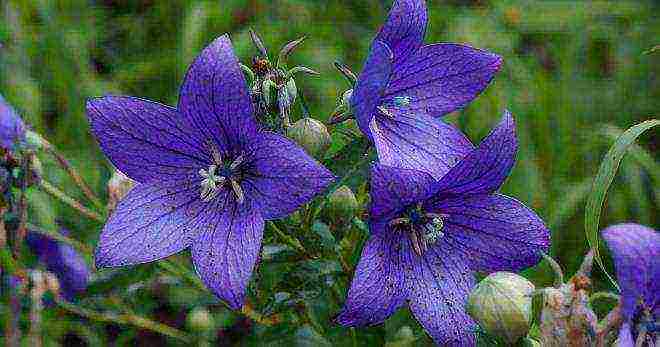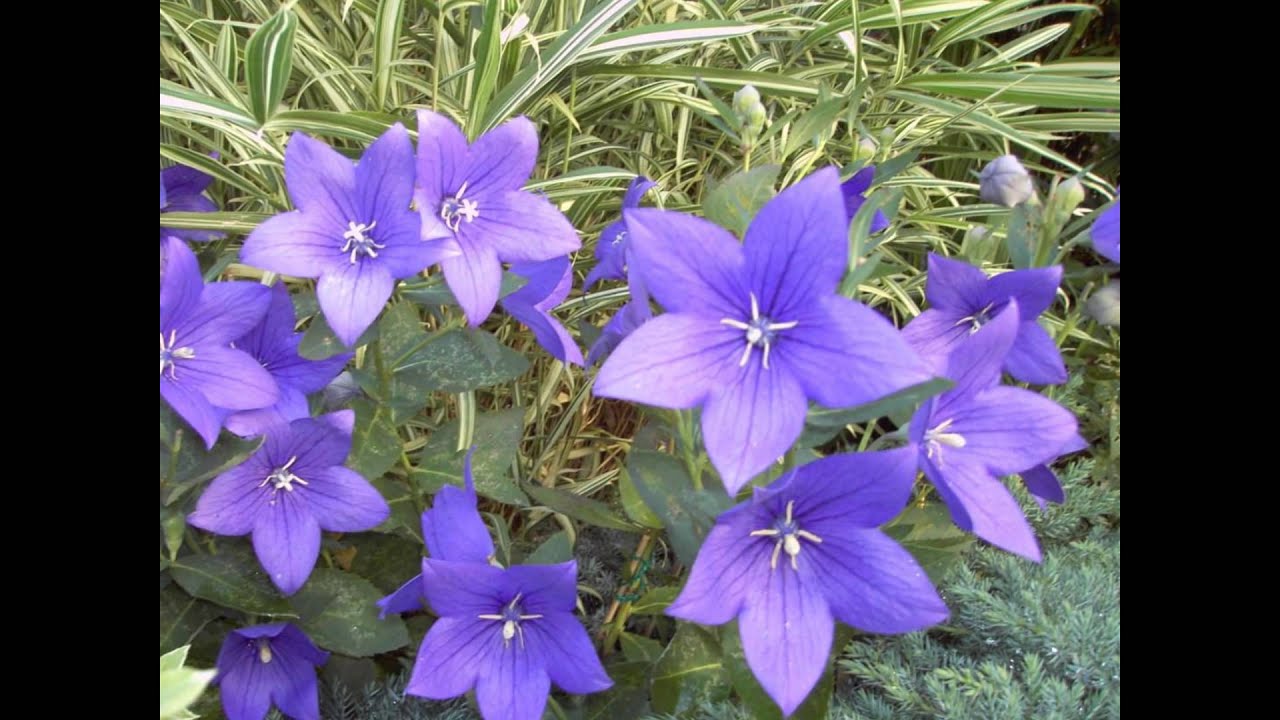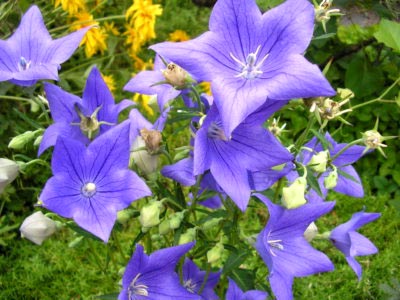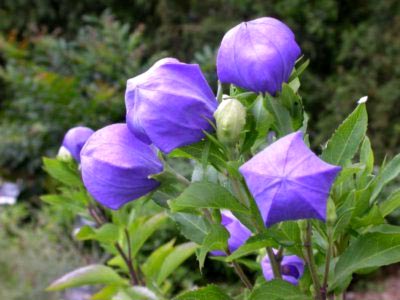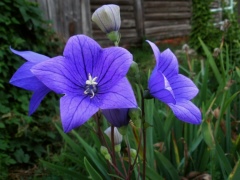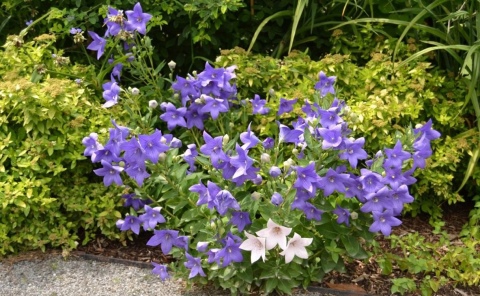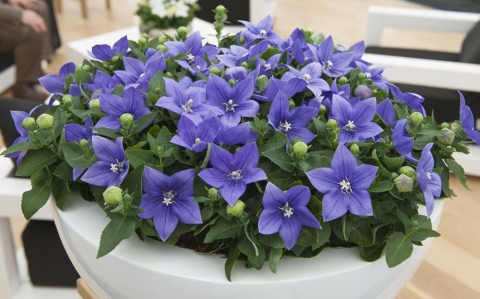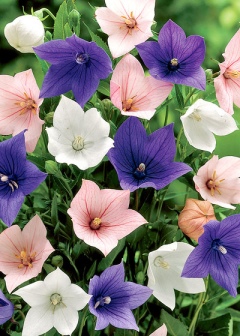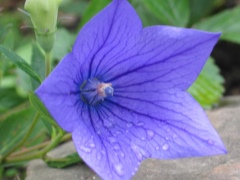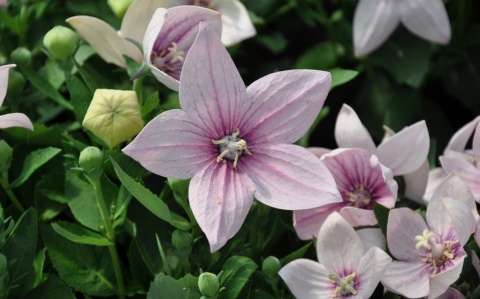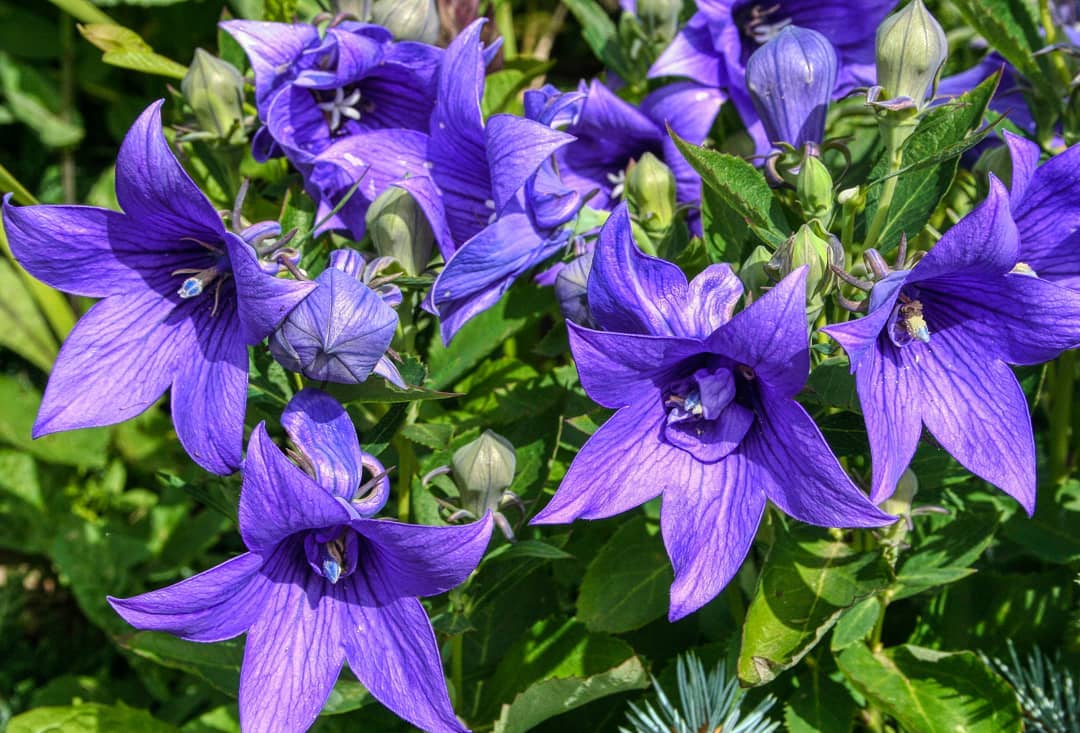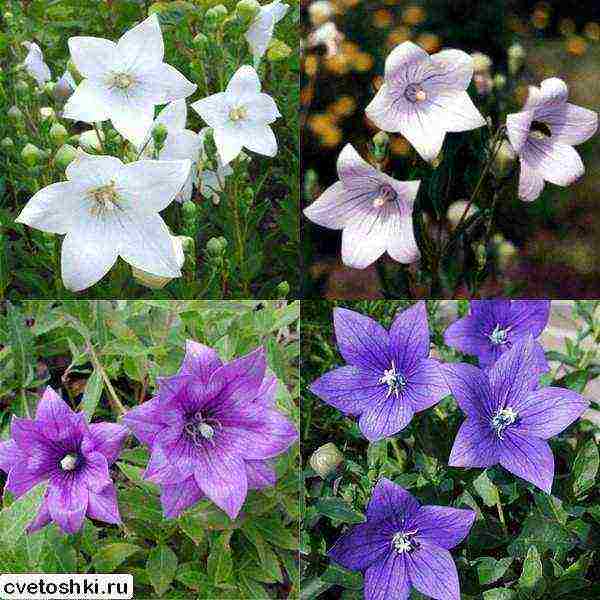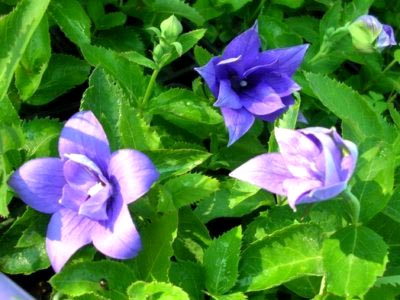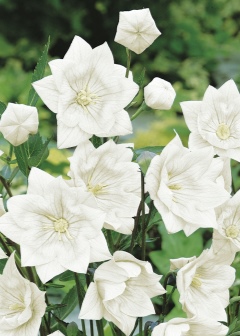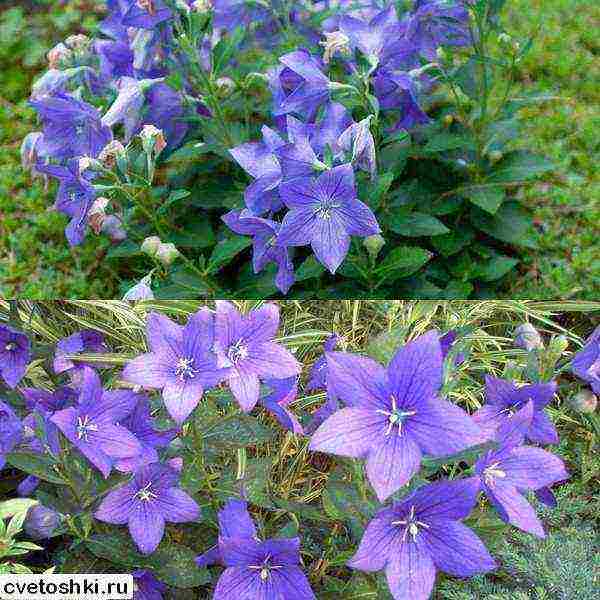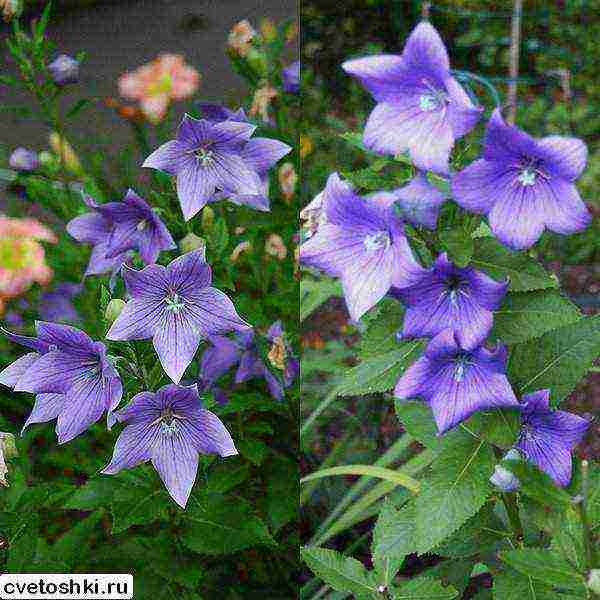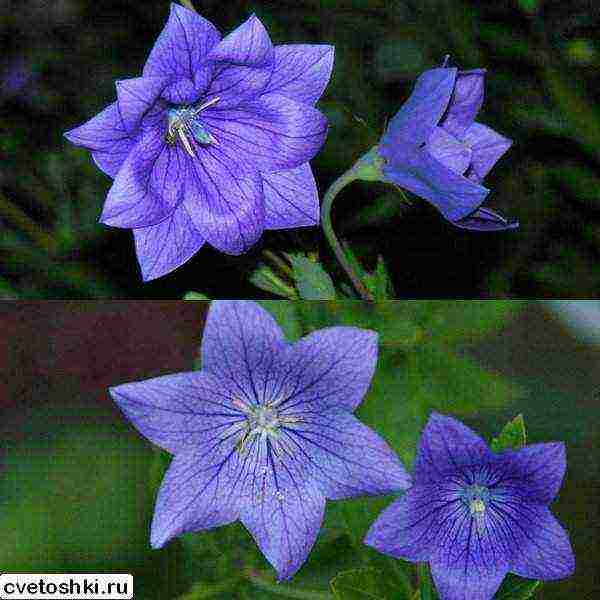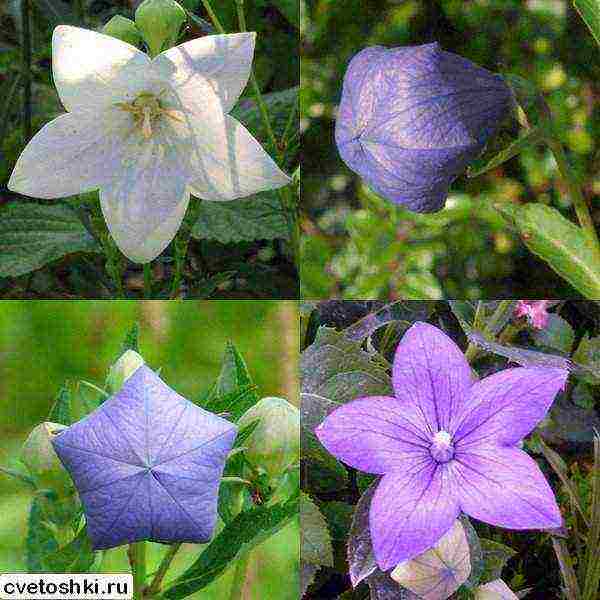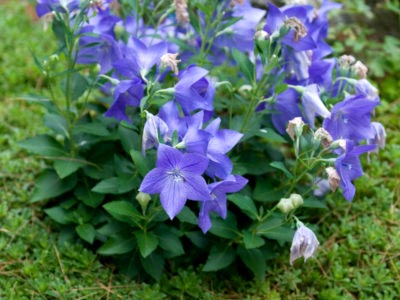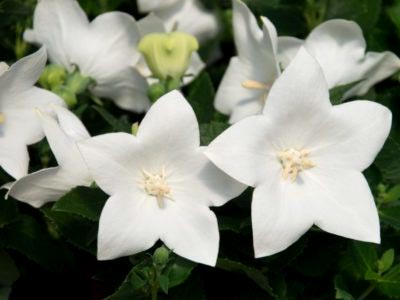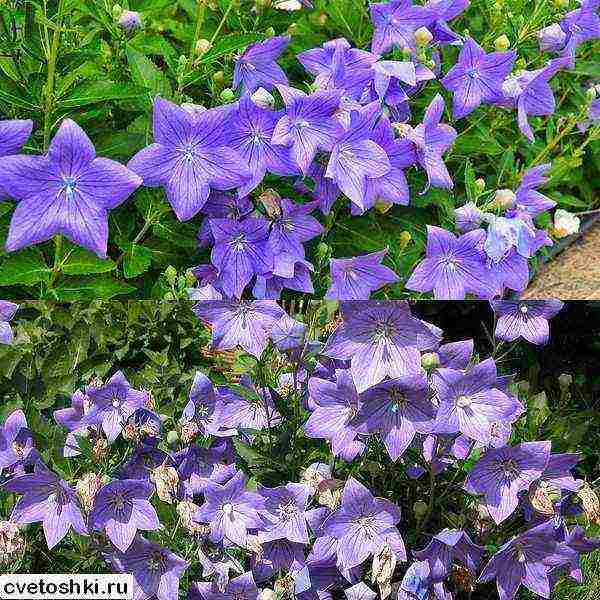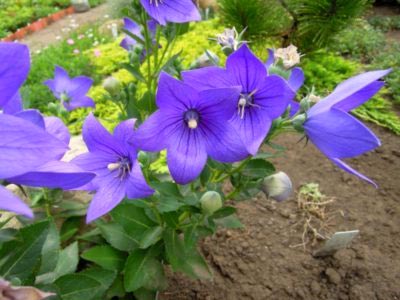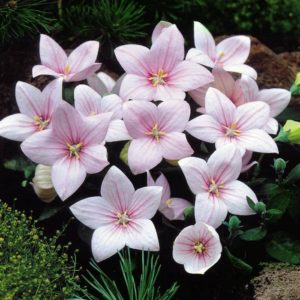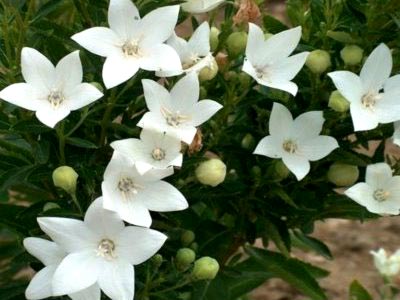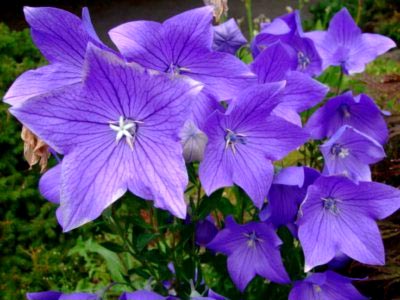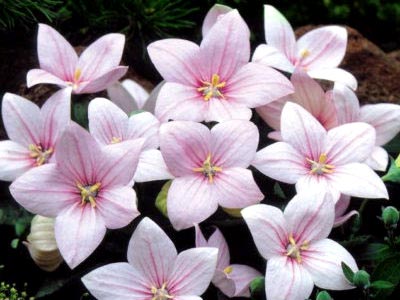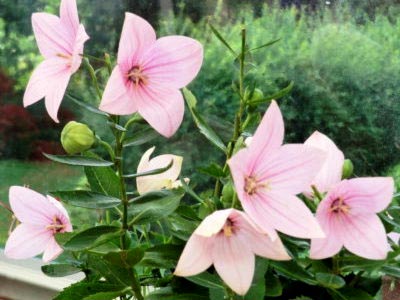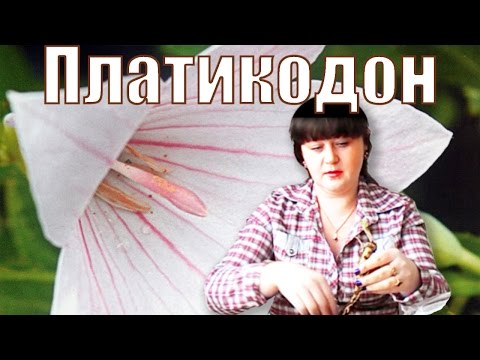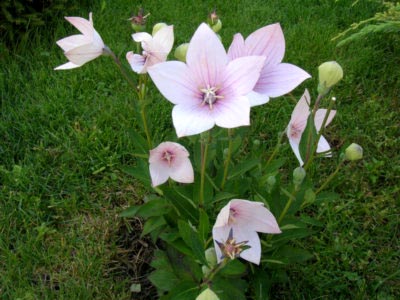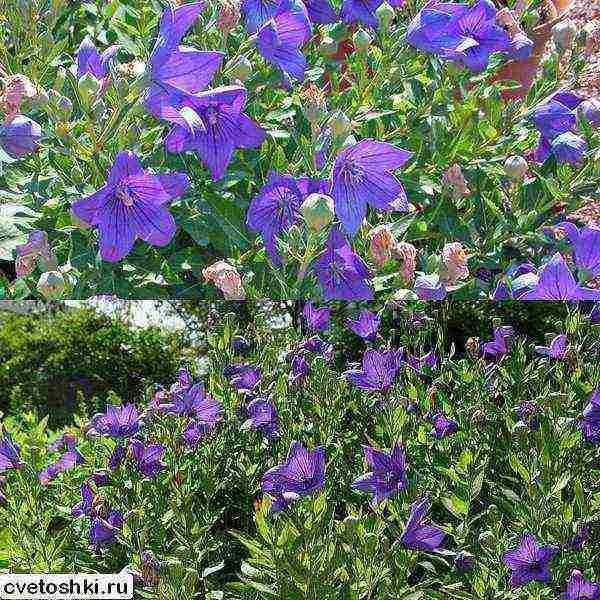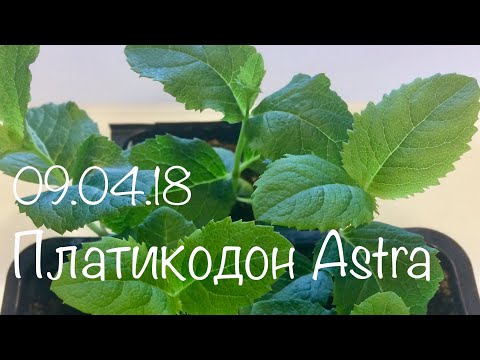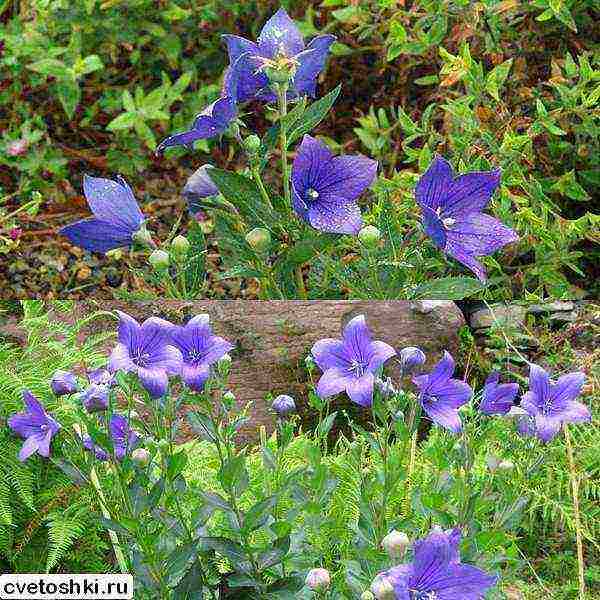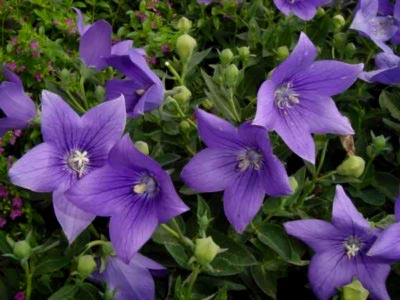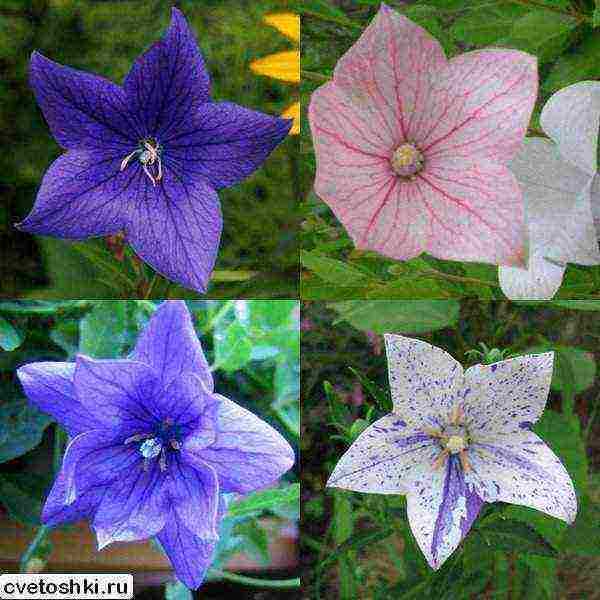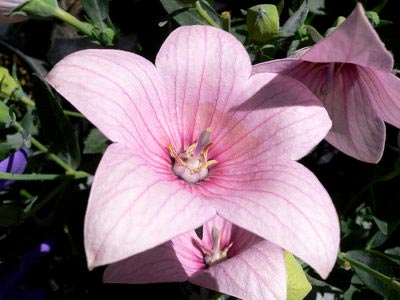Description of shirokolokolchik
Often this plant is considered a type of campanula and is called a broad-leaved bell.
These plants belong to the same family, but not to the same genus, therefore, it is erroneous to consider shirokokolokolchiki a variety of campanul.
- Platycodon is distinguished by a fur-bearing form of a bush, care and cultivation of it does not require labor.
- The foliage of the plant distinguishes it from the rest of the bells, while it blooms thickly and for a long time. Therefore, most gardeners prefer them instead of the usual campanula.
- Bushes up to 50-60 cm, the lush crown of which is formed from thin, straight-directed shoots, with age, the shoots of the bushes rise. Suitable for creating compositions.
- Platycodon bushes are lush, of incredible beauty, foliage grows densely. In places with a small amount of sunlight, the shoots stretch out, while the appearance of the bushes does not deteriorate at all.
- The foliage grows opposite to each other, the lower leaves form basal rosettes.
- The leaf is ovoid, elongated, with small denticles at the edges.
- The color of the foliage of different varieties varies - from rich green to grayish.
The peculiarity of this species is that the plant does not grow or develop for a long time, only before flowering begins active growth. Therefore, you should not be afraid that the plant has frozen in development, when in the spring the rest are gaining growth.
Bloom
Large bell-shaped flowers are the main advantage of wide bells.
Flowers are collected in rare panicles up to 5 pieces each and bloom at the same time, in rare cases - separately. Flowers up to 8 cm in diameter.
Each lobule of the corolla is covered with thin dark veins. The flowering of these plants lasts 2 months. The number of flowers does not change. The beginning of the flowering period is mid-July.
Flowers of all shades of blue. There are varieties of shirokokolokolchik with white and pink flowers.
Plant varieties
The genus of plants has only one species, Platycodon, which is also called large-flowered bellflower. At the same time, the plant has a wide variety of shades of flowers and leaves.
Popular varieties:
- Album. Large white flowers with thin blue veins. Bushes reach a height of 60 cm;
- Nanum are low bushes with light blue flowers with a slight shade of lilac and veins of a dark shade. The flowers are shaped like a star;
- Marisid reaches a height of 35 cm. Flowers are light blue;
- Apoyama is a dwarf variety with bushes up to 20 cm with bright coral flowers, suitable for cultivation in rocky soils;
- Captured with double flowers of a dark blue hue;
- Captured by Alba. Terry appearance of a white flower with expressive stamens;
- Fuji Pink - a variety with sparse bushes and large light pink flowers and a star shape;
- Snowflakes. White semi-double flowers;
- Mother of Pearl - bushes with pink flowers;
- Perlmutterschale with extraordinary delicate pink flowers and mother-of-pearl pattern.
Application in landscape design:
- are often used to create bright spots when planting lawns;
- used in landscape compositions;
- in compositions with bright soloists such as roses will serve as a background;
- planted in alternate flowering compositions;
- to create bouquets, cutting of flowers is done after all the flowers on the panicle have opened.
Other types of bells, phlox, or gypsophila are suitable neighbors for shirokokolokolok.
Pests and diseases
Like any other plant, platycodon can damage various pests and diseases.
Gray rot
The cause of infection is a fungus that spreads throughout the plant.To avoid this trouble, the bush is treated with foundationol or copper sulfate, and the old infected bushes are disposed of.
Mice and moles
It is much easier to deal with mice. It is necessary to spread the poison between the bushes, but with moles it is a little more difficult. It is necessary to stick one end of the hose into the hole, and connect the other to the exhaust pipe of the car and start the car. This will "smoke out" the mole. You can also place "rattles" around the area, which the mole is afraid of.
Slugs
They eat the leaves of the bush. To prevent this, it is necessary to pour ash or eggshells around the bushes, on which the slugs will not be able to move. Another option is to dig a glass of beer or milk into the ground, into which slugs will surely fall.
Tricks of growing platycodon
Occasionally in stores you can find platycodon seeds, which must be planted in early spring. Sowing under winter is also possible, but its results are slightly worse. For the first year, the plants do not need a lot of space, so the crops can be thickened, leaving about 15 cm between the rows for care.
The seedling bed should be in an open, sunny location. Be sure to peg the beginning and end of the row to help you find the plants next spring. Care consists in weeding and loosening the soil: delicate seedlings can easily become clogged with weeds.
In hot weather, watering is necessary. In early and mid-summer, plants can be fed with mineral fertilizers. In the fall, the aerial part dies off, and the root with a light purple bud of renewal, similar to a small white carrot, - caudex, remains underground.
Care of young seedlings
When the first shoots of the shirokokolokolchik appeared (as the common people call platycodon), watering must be carried out regularly. But as young shoots grow, the amount of water applied must be slightly reduced.
In addition, it is very important to carefully loosen the soil. This must be done so as not to damage young shoots.
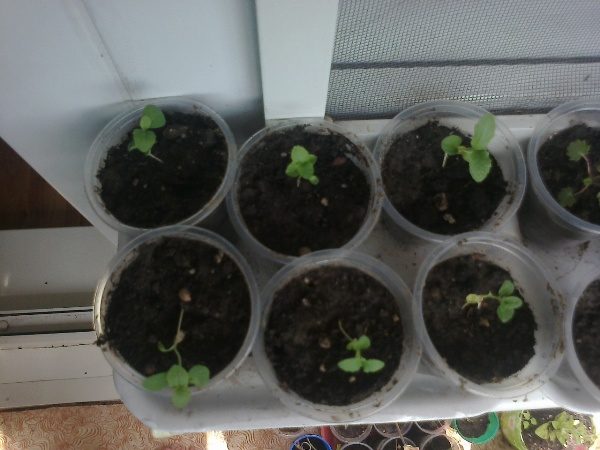
For reference, if you cover the seed crops with mulch, then loosening and watering can be carried out much less often.
When can you plant a plant in the fall? Into the still not frozen ground. But in this case, the seeds introduced into the soil must be covered with a thick layer of compost to avoid freezing. After planting platycodon in the open field in this way, it does not need care until spring.
Planting a plant
Platycodon planting and care in the open field is unassuming. Even the photo shows that the plant is maximally adapted to wild conditions.
Young grandiflora can grow in soil only when there is no threat of winter frost. It is then that flower seedlings are planted. Plants overwinter comfortably even at prolonged low temperatures.
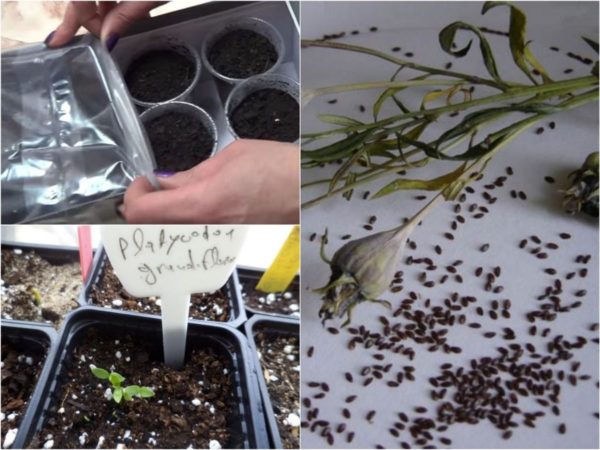
Important! In order to be guaranteed to get a flower in your personal plot or flower bed, it is advisable to use planting with seeds with growing seedlings.
Planting times vary by region. The farther south, the earlier they should be planted - mid to late March is ideal for this. For the middle lane, it is better to sow the plant in mid-April.
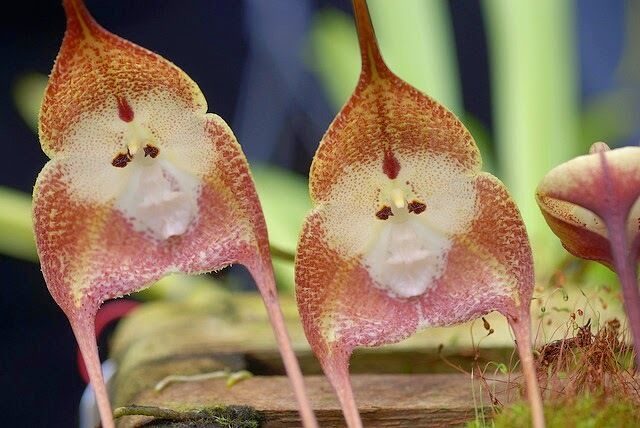 You may be interested in:
You may be interested in:
Description and care of the orchid Dracula or Monkey's face Orchid is one of the most popular home flowering plants. Many gardeners like to grow them at home ... Read more ...
For planting, you can buy soil for ordinary flower plants at the store. To make it yourself, you need to mix humus, sand and peat in equal proportions. When sowing, it is necessary to deepen the seeds by 3-4 mm.
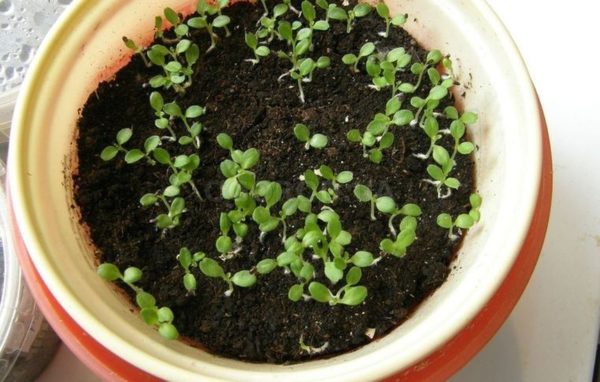 The seed box must be kept at room temperature. The most comfortable will be + 20-24 ° С. Watering should be carried out regularly, the earthen coma should not be allowed to dry out excessively.
The seed box must be kept at room temperature. The most comfortable will be + 20-24 ° С. Watering should be carried out regularly, the earthen coma should not be allowed to dry out excessively.
Seedlings appear in about 2-3 weeks. And as soon as this happens, it is necessary to move the box to a cooler place - the optimal temperature will be +16 ° C.
In such conditions, it is necessary to keep further young Platicodon plants until planting in open ground is required, where long-term growth and care will take place.
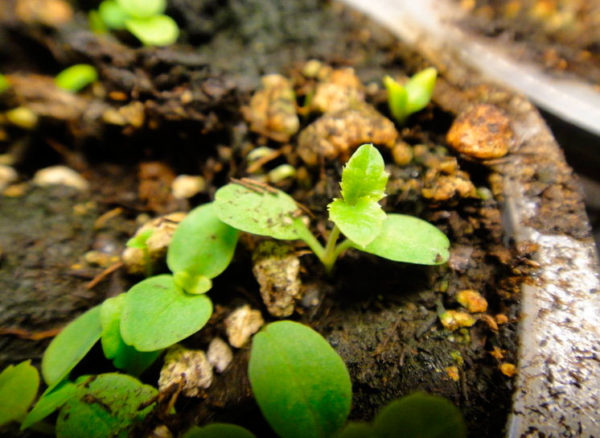
Compact spray asters
Varieties of perennial bush (shrub) asters represent another separate group. It includes species that are ideal for borders and rockeries. Their height does not exceed 1 m, although there are also more miniature specimens with a height of only 20-40 cm. Such compact bushes look very beautiful even when they are not blooming, and are considered dwarf.
The dense crown of asters consists of many branching branches. The shoots are completely covered with fine but elegantly colored foliage. With this amount, the dark green leaves make the aster look like a boxwood bush. And when they bloom in the fall, the small inflorescences cover the bushes with a bright solid cap. Another plus - such asters do not require transplanting until 5 years. Older bushes simply become too thick, and then they are divided for reproduction.
Some of the most beautiful and compact types of undersized bush asters are the following varieties:
- Blue Bird;
- Dwarf Nancy;
- Rosenwichtel;
- Blue Otumn;
- Blue Lagoon.
Astra Blue Bird
On this topic:
BACK
FORWARD
1 of 3
Aster shrub Blue Bird is one of the brightest representatives of the border flower species. The bush has a beautiful shape: it is thick and dense, like a green ball covered with flowers. Plant height averages about 30 cm. Aster blooms in early autumn, flowering lasts 2 months. The inflorescences are small, up to 2.5 cm in diameter, semi-double, but there are a lot of them. In blue asters, a large yellow center is clearly visible in the photo.
Astra Dwarf Nancy
Aster shrub Nancy dwarf grows to a maximum of 25 cm in height. The shoots are so densely spaced that the bush looks like a sphere. It blooms with lilac semi-double inflorescences from early to mid-autumn.
Astra Rosenwichtel
Shrub aster Rosenwichtel is distinguished by its lush forms and long flowering. The height of the bush does not exceed 30 cm, while it is very dense. Erect stems actively branch and are completely covered with dark green small foliage. Aster blooms in August and blooms until October. Pink asters darken as they fade, acquiring a reddish tint. The buds are large enough, up to 5 cm in diameter. The petals are arranged in several rows around the yellow core.
Astra Blue Otumn
Astra Blue Otumn is a hybrid variety, the parents of which are the common bush aster and the New Belgian one. From the first he took a compact size, and from the second - a bright color. The height of the bush is only 40 cm, while it grows in the form of a ball. In September, blue-violet buds with a yellow center bloom. Aster blooms until the coldest days.
Astra Blue Lagoon
A very beautiful variety with rounded bushes up to 50 cm high and dark green foliage. Flowering occurs in late summer and lasts until frost. The inflorescences are large enough for such a plant, they can reach 5 cm in diameter. In the center of the flower there is a large yellow core. Around it are bright purple petals in several rows.
Seed preparation and planting
To make the seedlings appear more friendly, the seed material can be stratified - treated with cold, placed in the lower section of the refrigerator for 1-3 months.
Before sowing, the seeds in a gauze bag are immersed in water for two days to swell. Then the prepared oval seeds are laid out on the surface of the moistened soil and lightly pressed. Some growers sprinkle the sowing with a very light layer of sand.
The first shoots of Platycodon appear in one to two weeks.
The seeded container is covered with polyethylene or glass and placed in a bright place with a temperature of 20-22 ° C. Condensation on the inside of the cover material is removed daily
Carefully moisten the soil only after its top layer dries. The first shoots appear in one to two weeks.
Seedling care
As soon as the seedlings are formed, the cover is removed and the temperature is lowered to 18-20 ° C. Seedlings are watered sparingly, and after watering, the top layer of the soil is loosened.
Seedlings with 3-4 true leaves are dived in containers with a diameter of 10 cm with a hole in the bottom and a drainage layer, filled with optimal loose soil. In such containers, young plants develop before planting in a permanent place.
Platycodon placement
A spectacular perennial bell of a compact variety can grow on a windowsill.
Platicodon can grow well on windowsill
In this case, he will need good drainage, light soil, a pot of sufficient volume, bright but diffused lighting and moderate watering with soft water. Container platycodon is transplanted only as needed in winter, when the plant is dormant, protecting the earthen ball as much as possible, since its vulnerable rhizomes are easily damaged.
Platycodon seedlings are planted in the open ground of the middle lane by the end of May or at the beginning of June.
For planting, choose a sunny place with a low standing groundwater and loose, neutral, well-drained soil. Loam loosened with sand is one of the optimal options for this plant.
Platycodon is planted in open ground in late May and early June
The planting zone is pre-dug up with the introduction of fertilizers: half a glass of wood ash and a tablespoon of complex mineral fertilizer for each square meter. You can make these compounds directly into the planting wells.
Planting holes, somewhat more spacious than seedling pots, are placed at intervals of 20-25 cm. Seedlings are pre-watered well to make it easier to extract the root system and reduce the traumatic effect of transplanting
Carefully transfer the seedlings into the prepared pits, add soil, compact it a little and water the new settlers. The soil is covered with a layer of peat chips or humus.
Outdoor care
For two weeks after planting, the plants are watered daily. Then watering is reduced in volume and frequency, limiting itself to moderate moisture every two days, after which the soil is loosened and weeded.
For two weeks after planting, Platicodon is watered daily.
They are fed monthly with a mineral complex for flowering plants.
To prevent the stems from stretching, they are pinched, stimulating branching. Bushes that have grown in height are tied to vertical supports. Withered flowers are removed so that new buds form more actively.
Platicodon is not susceptible to disease and is practically not affected by pests. In case of waterlogging, in combination with a thickened planting, a plaque of fungal gray rot may appear on the leaves and flowers. In this case, you need to loosen the soil well and reduce watering. Severely damaged plants should be removed, and the rest should be sprayed with a solution of copper sulfate.
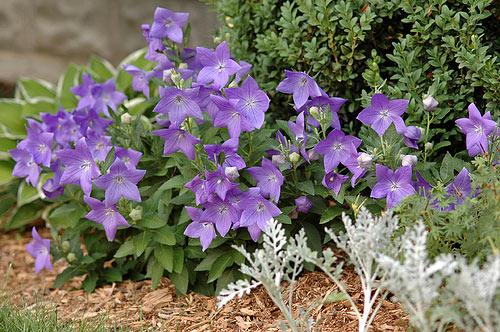
Platicodone is not susceptible to disease
In the fall, the platycodon foliage turns bright yellow - the bush again decorates the site. Then the aerial part is cut off and the wintering rhizome is covered with a layer of mulch (peat, fallen leaves, sawdust) of two to three centimeters.
Cutting and dividing the rhizome: the area of risk
Vegetative methods of reproduction of Platycodon are unsuccessful, however, they ensure the preservation of the variety of the original plant.
Cuttings (for two knots with a heel) are harvested in the spring and the lower cuts are treated with charcoal powder. They are buried in moist light soil (peat with sand in equal proportions) and, covered with a film, are kept at a temperature of about 20 ° C. Ventilate regularly and moisturize moderately. Within a month, a root system is formed.The main danger in this case is stem decay, which occurs especially easily in platycodon in conditions of high humidity.
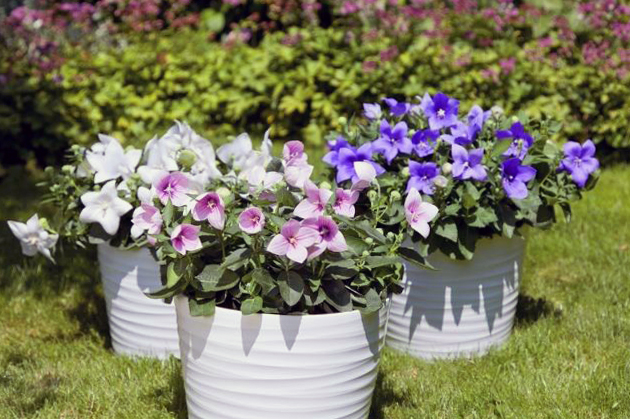
Platycodon cuttings are harvested in spring
If the rhizome grows in very loose sandy soil, it can be divided into parts with growth buds with a sharp tool. The slices are sprinkled with ash and the cuttings are planted. This method of reproduction is also not always successful, since the platycodon rhizome hardly tolerates even minor damage.
In any case, reproduction of Platicodon by sowing seeds for seedlings remains a guaranteed way to grow a spectacular flower garden of exceptionally large bells with five or more petals of the most delicate shades.
Seed planting methods
There are several ways to sow seeds for seedlings, each of them deserves attention.
- The traditional way. To begin with, the containers must be filled with earth, put the seeds on top, cover the crops with foil. Containers with seedlings should be kept in a warm place, observing the temperature regime within +22 ° C.
- Peat tablets. This method has recently been gaining immense popularity, because the tablets are easy to use. Peat washers must be placed in a container, pour warm water, leave alone for 20 minutes. Then the seeds need to be slightly buried in a tablet, and the containers must be removed to a warm place.
- Seedling snail. Experienced growers are increasingly growing seedlings in snails. A simple fixture saves space in the house. To build a structure, you will need to prepare a tape 10 cm wide. You need to fill it with earth, and put seeds on top. All that remains is to twist the canvas into a roll and put the snail vertically in the box.
Interesting! How to grow Gatsania from seeds at home
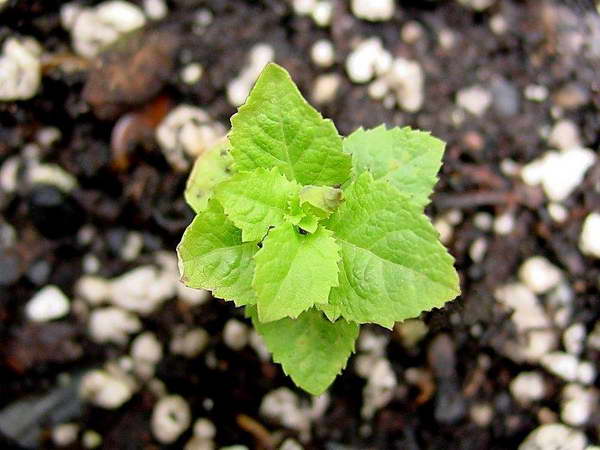
Reproduction
Alpine carnations are grown mainly from seeds, but it is more reliable to plant them on seedlings at home. And already a little stronger seedlings are planted in open soil. When propagated in this way, the plant begins to bloom in the first year. You can sow seeds for seedlings from January to March. In order for the seeds to sprout quickly and amicably, they need to be prepared for this.
- To increase the similarity, they can be kept in warm water for 24 hours.
- Soil is poured into containers or special cassettes and seeds are placed, keeping a distance of 2 cm between them.The planting depth should be 1 cm.
- Sprinkle the planted seeds on top with a thin layer of sand.
- The containers are covered with foil or glass and placed in a warm place, remembering to ventilate and humidify.
After 2 weeks, shoots should appear, then the shelter can be removed. It is better to prepare the soil in advance; for this, in the fall, the soil from the garden is mixed with ash and sand. You can also use a ready-made commercial substrate, the main thing is that it must be neutral and nutritious. The soil should be treated with a solution of potassium permanganate in order to destroy possible microorganisms.
The sprouts should be watered with settled cold water, but this must be done carefully so as not to overmoisten, since they are prone to being affected by fungal diseases. Seedlings need lighting for 14 hours for normal growth, so it is worth taking care of additional lighting. When 2-3 leaves are formed on the sprouts, they dive, but before that they need to be well moistened.
The day before disembarkation, they are left in the fresh air all day. You can immediately sow seeds in open soil when it warms up well, it is recommended to do this at the end of May. On the site, shallow grooves are made, the distance between which is 10 cm. Clove seeds are sparsely sown in them, previously mixed with sand and a small amount of dry mineral fertilizers, covered with earth and moistened with warm water. From above, the bed should be covered with a film, and when shoots appear, it is recommended to use lutrasil (a type of agrofibre) instead of it for another 2 weeks.
You can water the plant directly through the material.The hardened sprouts must be pinched, this procedure contributes to the more lush forms of the bush and the formation of a larger number of buds. You can also propagate an alpine carnation:
- cuttings;
- layering;
- dividing the bush.
Cuttings are cut at an angle from the side shoots, their length should be 10 cm. In the lower part, the stem is cut and placed in a container with moist soil. After about 2 weeks, roots form on the stems, and the plants are ready to be transplanted to a permanent location.
To breed the carnation with layering, a long, strong shoot is rejected from the mother bush, cut in the lower part (an incision is about 4 cm long), a small depression is dug near the bush, the layering is placed there and sprinkled with earth. The next year, it is separated from the parent bush and transplanted separately. In early spring, while the plant has not started to grow, you can use reproduction by dividing the bush.
Delenki are planted in the soil, keeping a distance so that the bushes can grow.
Large bells on lush curtains
The plant, which we often mistakenly call the broadleaf bell, has nothing to do with campanula, except for a common family. Platycodon (Platycodon) is a separate genus of plants, the legal name of which is only one - shirokokolokolchik. And confusing it with Campanula latifolia would be a big mistake. After all, Platycodon is a much more lush plant, and besides, it is easy to grow.
A medium-sized and hardy perennial with very beautiful foliage, not typical for most bells and luxurious long flowering - such platycodons will appear before every gardener who dares to prefer a rarer shirokokolokolchik to ordinary campanulas. In height, this plant is usually limited to 50-60 cm, while the bushes are lush, the shoots are numerous, thin and straight, rising in old bushes, and the clumps seem a little wider than tall.
Depending on the light, the thin shoots of Platycodon can stretch slightly, but the bushes always remain lush and attractive, and the foliage is quite dense. Platycodon leaves are arranged oppositely, the lower ones are collected in basal rosettes, ovoid or elongated, narrow with a beautiful finely toothed edge. Depending on the variety, the foliage can be either dark green or bluish. Platycodon has one significant feature: the plant shows signs of growth very late, in fact, shortly before the beginning of flowering.Therefore, you should not be afraid that in the middle of spring there are no signs of revival on Platicodons: it will quickly catch up with its competitors and surprise with its growth rates.
The main advantage of the plant is its large and wide "bells" of flowers. Inflorescences of platycodons really cannot be called otherwise than broadly bell-shaped. In rare panicles, up to 5 large flowers are collected, less often they bloom one by one. Reaching 8 cm in diameter, they are perfectly symmetrical in shape and create a rounded cup. The corolla lobes are decorated with the finest dark veins. The platycodon parade continues for 2 months. However, the number of flowers per plant seems remarkably constant. Platycodon bloom starts in mid-July.
The range of colors includes not only various shades of blue. Shirokokolokolchik flowers can be colored both white and pink.
Shirokolokolchik, or Platycodon white. Stefano Stefano Stefano
How to take care of it properly?
Caring for Chinese wisteria at home is quite simple, because such a plant does not even need pruning. Complex mineral fertilizers are used twice: when the buds begin to form and when they open. Irrigation should be regular, as the soil should always remain slightly moist.In June, the tree can be transferred to the balcony, and in winter it is imperative to ensure peace at a temperature of 6 to 8 degrees. It is best if wisteria is grown on the windowsill of a window facing south. If the leaves of a house plant become poorer, then perhaps the problem lies in the excessive acidification of the soil. You can eliminate it with iron salts.
Watering
If the cultivation of wisteria takes place in the open field, then it is better to focus on the condition of the soil. Excess moisture will lead to decay of the root system, but the lack of moisture will be critical. When the active formation of buds begins, it makes sense to additionally carry out the spraying procedure. By the beginning of September, watering is reduced to almost a minimum.
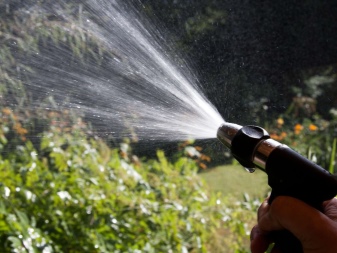
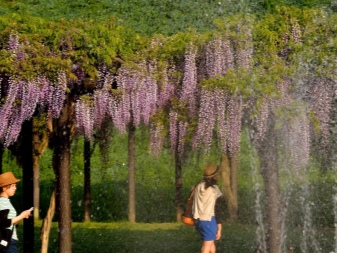
Fertilizer
Once a season, Chinese wisteria must be fertilized with a chalk solution, for the preparation of which 100 grams of the substance must be diluted in 10 liters of liquid. Also, when buds begin to form, a mineral complex and organic matter should be added in the form of cow dung, part of which is dissolved in 20 parts of water. The same happens during the flowering period.
It is important to remember that all dressings are carried out one after the other.
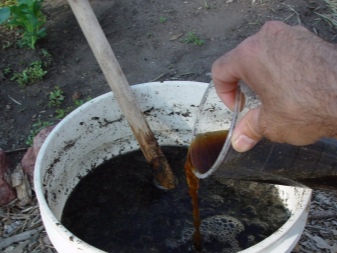
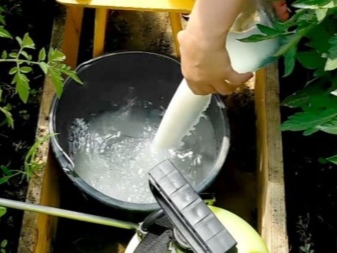
Pruning
Formative pruning is carried out in the second or third year of the plant's life. The procedure is carried out in the summer. Healthy shoots are shortened by 3-4 buds, and dried or spoiled ones are completely removed. In spring, at the beginning of the season, it also makes sense to carry out a similar treatment in order to rid wisteria of shoots that have not survived the winter.
It is important to mention that the older the liana, the longer its roots, so replanting it will be an almost impossible task. Therefore, a permanent habitat should be chosen carefully.
Wisteria grows necessarily with the use of a support, as it is recommended to take strong wooden or metal pergolas from one or more rows. In winter, the culture needs to provide a secure shelter.

